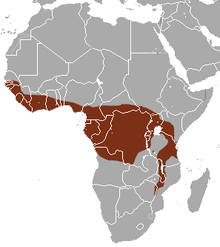African palm civet
| African palm civet[1] | |
|---|---|
| | |
| Scientific classification | |
| Kingdom: | Animalia |
| Phylum: | Chordata |
| Class: | Mammalia |
| Order: | Carnivora |
| Suborder: | Feliformia |
| Family: | Nandiniidae Pocock, 1929 |
| Genus: | Nandinia Gray, 1843 |
| Species: | N. binotata |
| Binomial name | |
| Nandinia binotata Gray, 1830 | |
 | |
| African palm civet range | |
The African palm civet (Nandinia binotata), also known as the two-spotted palm civet, is a small mammal, with short legs, small ears, a body resembling a cat, and a lithe tail as long as its body. Adults usually weigh 1.70 to 2.10 kg (3.7 to 4.6 lb). It is native to the forests of eastern Africa, where it usually inhabits trees. It is omnivorous with a diet that includes rodents, insects, eggs, carrion, fruit, birds and fruit bats. The animal is generally solitary and nocturnal.
Distribution
The African palm civet ranges throughout much of sub-Saharan Africa and occurs from day its range extends from South Sudan to Guinea, south to Angola and into eastern Zimbabwe.[3]
Habitat
The African Palm Civet is and adaptable species which occurs in a wide variety of habitats from deciduous forests and lowland rainforests, to river and savanna woodlands.[3]
Habits
The African palm civet is a crepuscular, solitary animal which emerges for a few hours around dawn and dusk to hunt for food. They are mainly arboreal animals. spending the majority of the daylight and night-time hours sheltering in trees. Despite their otherwise solitary natures, African palm civets have been known to congregate in groups of as many as 15 animals if food is abundant. They have two sets of scent glands on the lower abdomen and between the third and fourth toes on each foot,which secrete a strong smelling substance which is used tom mark territory and in mating.[3]
African palm civets breed up to twice in a year the first litter is born in May and the second in October which is during the rainy season, when food is more abundant and readily available. The female usually gives birth after a gestation period of 2–3 months and the litter is as many as 4 young which are suckled by their mother until they grow strong enough to fend for themselves when they are weaned, usually at around 3 months old. While she has suckling young the female'smammary glands produce a orange-yellow liquid which discolours her abdomen and the young civets' fur, this is thought to discourage males from mating with nursing females.[3]
The African palm civet is omnivorous and pineapples and other fruits make up the majority of its diet. This is supplemented with rodents, lizards, birds and frogs, as well as invetebrates. African palm civets feed by holding their prey in their hand-like front paws, biting it repeatedly and then once dead then swallowing it whole.[3]
Taxonomy and evolutionary history
Nandiniidae consists of just one genus and one species and is classified in the order Carnivora and the suborder feliforma. Nandiniidae was previously classified in the family Viverridae; hence it is commonly referred to as a Civet.[4] However, morphological analysis suggested it should be placed in separate taxon from civets, and molecular genomic data has supported this claim. They are classified as their own separate family which differentiated from the rest of the suborder Feliformia 44.5 million years ago.[5]
Although resembling other civet species (in the family Viverridae), it has been suggested that the African palm civet is genetically distinct, and diverged from other civets before the cats did. They are therefore classified as the only species in the genus Nandinia and in their own family, Nandiniidae, although this suggestion is not universally accepted.[5]
Threats and conservation
The International Union for the Conservation of Nature and Natural Resources has classified the African palm civet as Least Concern. Possible threats to the survival of this civet include habitat loss and hunting for bushmeat. These animals are common in the meat markets of western African countries such as Equatorial Guinea, Gabon and Guinea. At times they may be killed for medicinal purposes and to protect poultry.[2]
See also
References
- ↑ Wozencraft, W.C. (2005). "Order Carnivora". In Wilson, D.E.; Reeder, D.M. Mammal Species of the World: A Taxonomic and Geographic Reference (3rd ed.). Johns Hopkins University Press. pp. 532–628. ISBN 978-0-8018-8221-0. OCLC 62265494.
- 1 2 Van Rompaey, H.; Gaubert, P. & Hoffmann, M. (2008). "Nandinia binotata". IUCN Red List of Threatened Species. Version 2008. International Union for Conservation of Nature. Retrieved 22 March 2009. Database entry includes a brief justification of why this species is of least concern
- 1 2 3 4 5 "African palm civet". A-Z Animals. Retrieved 2016-11-08.
- ↑ "African Palm Civet Family (Nandiniidae) - Information on African Palm Civet Family - Encyclopedia of Life". Encyclopedia of Life. Retrieved 2015-11-30.
- 1 2 Eizirik, Eduardo; Murphy, William J.; Koepfli, Klaus-Peter; Johnson, Warren E.; Dragoo, Jerry W.; Wayne, Robert K.; O'Brien, Stephen J. (2010-07-01). "Pattern and timing of diversification of the mammalian order Carnivora inferred from multiple nuclear gene sequences". Molecular Phylogenetics and Evolution. 56 (1): 49–63. doi:10.1016/j.ympev.2010.01.033.
| Wikispecies has information related to: Nandinia binotata |
| Wikimedia Commons has media related to Nandinia binotata. |
